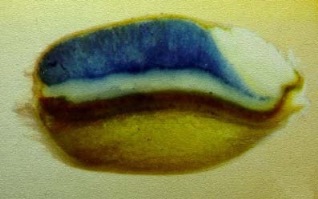Development of a seed-based strategy for the design of a mucosal vaccine against S. pneumoniae
SUPERVISOR: EVA STÖGER
Background.
Plant manufacturing systems offer an important financial benefit because the capital investment/cost of entry is substantially lower than that of a new fermentation-based manufacturing facility. The lower up-front costs are particularly attractive to low and middle-income countries with region-specific health issues (such as infectious diseases), which are often ignored by the major pharmaceutical companies (Stoger et al., 2014). A further reduction in cost could be achieved by utilizing the plant matrix as delivery vehicle (Jacob et al., 2013). In addition, delivery within a durable matrix resists digestion and increases exposure to immune effector cells. For example, Protalix Biotherapeutics is currently exploring the potential use of lyophilized carrot cells for the oral delivery of recombinant glucocerebrosidase (taliglucerase alfa).

Protein encapsulation is particularly effective in cereal seeds that contain dedicated organelles for storage proteins (Takaiwa, 2013)). Storage proteins such as zeins (maize) and hordeins (barley) have already been considered for slow-release pharmaceutical designs (Wang et al., 2011), thus naturally occurring protein bodies may provide an ideal encapsulation platform for recombinant pharmaceuticals produced in plants. Purified polysaccharide and conjugate vaccines are available for preventing infections with Streptococcus pneumoniae, a pathogen responsible for high morbidity and mortality rates, especially in developing countries. However, polysaccharide-based vaccines have some important limitations, such as being serotype-dependent, less immunogenic in young children and of high manufacturing complexity and cost (Verhoeven et al., 2014). Protein-based vaccines are therefore desirable to complement polysaccharide conjugate vaccines and to confer coverage against a broad range of serotypes.
Aims and methods.
We propose to develop barley plants for the production of recombinant subunit vaccines against Streptococcus pneumoniae, and to investigate a bioencapsulation and receptor-mediated uptake strategy that allows the mucosal delivery of the vaccines. Our collaborators at the University of Dhaka, Bangladesh, have screened a collection of pneumococcal clinical isolates and provided information for a number of vaccine candidates. To take advantage of seed storage organelles for the improved bioencapsulation of the antigens, the expression constructs will include signal sequences that cause recombinant proteins to accumulate within prolamin containing storage organelles that are unique to cereal seeds (Rademacher et al., 2008). In vitro pepsin digestion will be used to confirm increased resistance to digestion in the stomach.
To promote antigen uptake through the gut mucosa and to achieve effective T‐cell presentation we will explore two strategies. The first will be based on human IgG1 fusion proteins to promote antigen uptake via the neonatal Fc-receptor, which is not only expressed in newborns but also in adults, where it is responsible for immunological surveillance (Rath et al., 2013). The second is based on the use of cell penetrating peptides (CPPs; Sakuma et al., 2012). Certain CPPs such as sweet arrow peptide (SAP) are closely related to cereal prolamin sequences, potentially supporting a strategy in which the effects of CPPs and bioencapsulation into prolamin bodies could be combined. The plant-derived antigens will be characterized by standard molecular approaches including ELISA, MS and PAGE, and their localization within cereal storage organelles will be confirmed by electron microscopy. In collaboration with our international partners, proof of concept immunization studies will be carried out in mice and rabbits. We will test both systemic and mucosal immune responses, including combinatorial administration regimes, e.g. systemic immunization followed by oral booster vaccinations. These experiments will evaluate the anticipated added value achieved by protein body encapsulation, IgG fusion and fusion to CPPs in animal studies.
Jacob, S.S., Cherian, S., Sumithra, T.G., Raina, O.K., Sankar, M. (2013) Edible vaccines against veterinary parasitic diseases−current status and future prospects. Vaccine 31, 1879-1885
Rademacher, T., Sack, M., Arcalis, E., Stadlmann, J., Balzer, S., Altmann, F., Quendler, H., Stiegler, G., Kunert, R., Fischer, R., Stoger, E. (2008) Recombinant antibody 2G12 produced in maize endosperm efficiently neutralizes HIV-1 and contains predominantly single-GlcNAc N-glycans. Plant Biotechnol. J. 6, 189-201
Rath, T., Kuo, T.T., Baker, K., Qiao, S.W., Kobayashi, K., Yoshida, M., Roopenian, D., Fiebiger, E., Lencer, W.I., Blumberg, R.S. (2013) The immunologic functions of the neonatal Fc receptor for IgG. J. Clin. Immunol. 33, S9-17
Sakuma, S., Suita, M., Inoue, S., Marui, Y., Nishida, K., Masaoka, Y., Kataoka, M., Yamashita, S., Nakajima, N., Shinkai, N., Yamauchi, H., Hiwatari, K., Tachikawa, H., Kimura, R., Uto, T., Baba, M. (2012) Cell-penetrating peptide-linked polymers as carriers for mucosal vaccine delivery. Mol. Pharm. 9, 2933-2941
Stoger, E., Fischer, R., Moloney, M., Ma, J.K. (2014) Plant Molecular Pharming for the Treatment of Chronic and Infectious Diseases. Annu. Rev. Plant. Biol. 65, 743-768
Takaiwa, F. (2013) Update on the use of transgenic rice seeds in oral immunotherapy. Immunotherapy 5, 301-312
Verhoeven, D., Xu, Q., Pichichero, M.E. (2014) Vaccination with a Streptococcus pneumonia trivalent recombinant PcpA, PhtD and PlyD1 protein vaccine candidate protects against lethal pneumonia in an infant murine model. Vaccine 32, 3205-3210
Wang, R., Tian, Z., Chen, L. (2011) Nano-encapsulations liberated from barley protein microparticles for oral delivery of bioactive compounds. Int. J. Pharm. 406, 153-162
